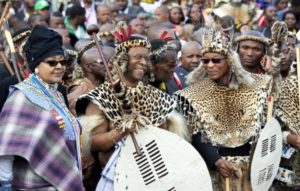22.4.2017 05:31 am
William Saunderson-Meyer


President Jacob Zuma joins King Goodwill Zwelithini (C) at a traditional wedding ceremony in Ulundi in KwaZulu-Natal at the weekend. Zwelithini has tied the knot with his sixth wife Zola Mafu. Also pictured is ANC stalwart Winnie Madikizela-Mandela (L). Picture: Reinhardt Hartzenberg
If Zuma’s bold plan is realised, the economic stagnation blighting the Transkei will be replicated throughout rural SA.
I was in another country this week – or to be accurate, what once supposedly was another country, the Transkei.
It was also a chilling reminder of what SA might in a generation look like if land expropriation and redistribution take place as conceived by President Jacob Zuma’s government.
The Transkei was always different from the other apartheid-era Bantustans. It was the first homeland, it was the biggest one and it had considerable territorial integrity.
For these reasons and because of its rich agricultural land and tourism opportunities, the Transkei was really the only one conceivably viable.
Yet, even with everything going for it in terms of resources, it never did blossom. And despite two dozen years of ANC government, not much has changed.
Agricultural development remains poor, despite fertile soils and good rainfall. Tourism, despite the savage beauty of its Wild Coast, is minuscule compared to what it could be.
A decade ago, I hiked part of the Wild Coast, overnighting in the few hotels that are strung along the coast. This week I did it again.
The experience was one of entering a time warp, stepping back 40 or 50 years. The places are comfortable but uninspiring. Hospitality, though warm and genuine, is below the standards that serious tourism demands.
Despite grandiose plans, the same is true of agriculture. The Eastern Cape – which the Transkei and the other Xhosa-language homeland, the Ciskei, are geographically parts of – is a mess, with economic and health indicators that are worse than the national norm.
The trunk road running north-south through the Transkei has improved marginally. But the branch roads that could and would draw international tourists in their droves, are atrocious.
The N2 Wild Coast Toll Highway, which would have a significant economic impact on the Transkei, remains stalled by environmental activists, who overwhelmingly are comfortably ensconced in the wealthier suburbs of SA’s major cities.
But the core problem faced by the Transkei is not difficult to diagnose. It is a simple matter of property rights. It is the curse of communal land tenure under a chieftainship system.
Without the right of the individual to own property – meticulously demarcated, mapped and recorded in a transferable title deed – the Transkei cannot realise its phenomenal potential. At present everyone, from subsistence farmer to hotel “owner”, exists at the whim of the chief who controls the land upon which they are essentially squatting.
A Permission to Occupy (PTO) certificate would have been issued on the say-so of the local chiefs and registered with various government departments. But the PTOs are legally flimsy, offering little protection to their holders. They cannot be sold, ceded, bonded or inherited.
The “radical economic transformation” that Zuma envisages involves the seizure of land without compensation and that the “traditional authorities”, the chiefs, will hold considerable power in the dispensation of rural land.
That means that the Transkei scenario will be repeated endlessly through the land. It will mean corruption, patronage and insecurity.
And it means that the economic stagnation that blights the Transkei, despite everything that is going for it, will be replicated throughout rural SA.
So the apartheid dream, perversely, may yet be realised, in that one day all rural South Africans will be Bantustan citizens.

William Saunderson-Meyer
For more news your way, follow The Citizen on Facebook and Twitter.
Zuma’s economic transformation could return rural SA to Bantustans
